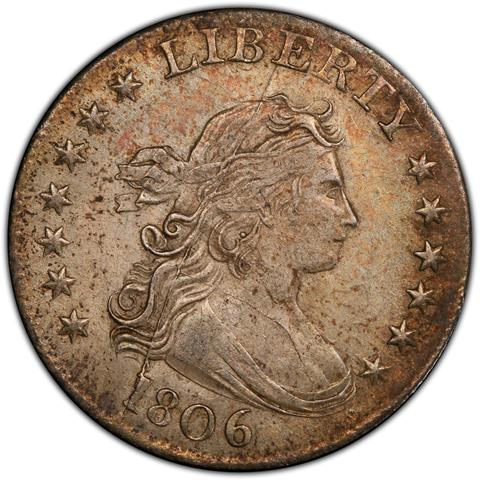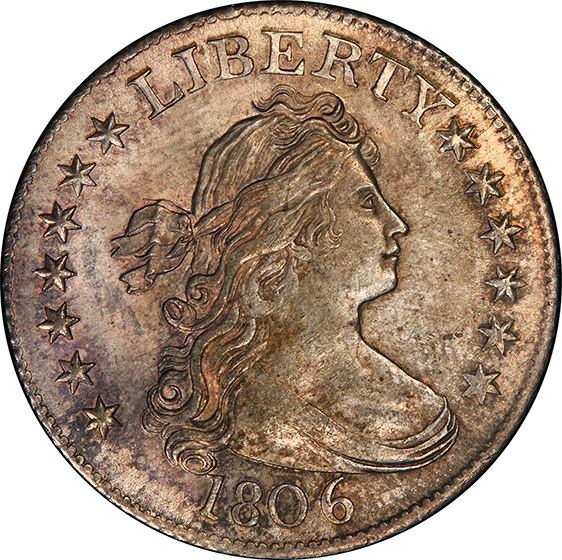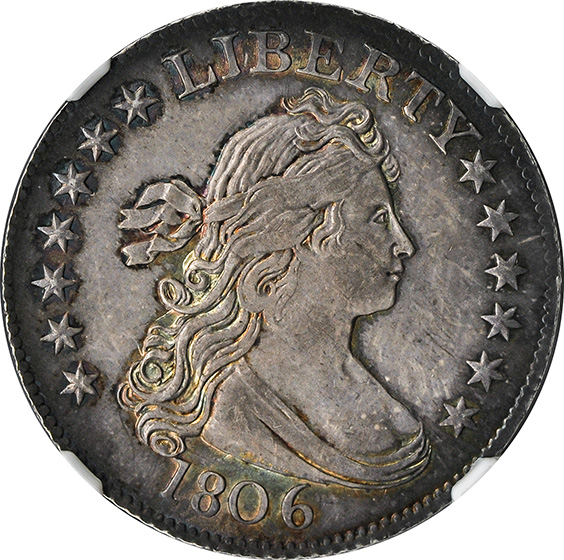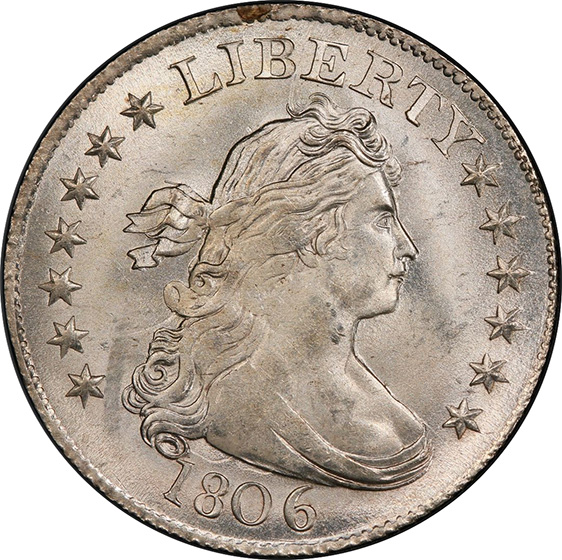Draped Bust, Small Eagle (1796)
On September 17, 1796, George Washington delivered his now famous Farewell Address in which he cautioned that “it is our true policy to steer clear of permanent alliance with any portion of the foreign world.” This policy of “no entangling alliances,” as it became better known, was to be the dominant theme of American foreign policy for the next one hundred and fifty years, right up to the start of World War II.
At the same time, the fledgling Philadelphia Mint was preparing to manufacture a new denomination, the quarter dollar, authorized by the Mint Act of 1792. It would eventually be recognized and accepted throughout the world.
It is difficult to imagine today how seriously coinage was regarded two hundred years ago. Officials understood that once coins left the mint, they would become metallic emissaries of the new nation. This is why so much attention was given to gold and silver coins weighing exactly what they were supposed to weigh, no more and no less. Most educated people of the day understood that a poorly designed coin would reflect badly on their country, just as a handsomely designed coin of proper weight and fineness would be respected worldwide.
The design of the 1796 quarter dollar had its genesis in the almost universal dislike for the previous coin designs. Earlier copper coinage, such as the Chain cent and Wreath cent, had not been well received by the public, and the Flowing Hair design of the silver coins was widely criticized. To avoid such public embarrassment with the new design, Mint Director Henry DeSaussure engaged renowned portraitist Gilbert Stuart, who supposedly used as his model the prominent Philadelphia socialite Mrs. William Bingham (nee Ann Willing). The likeness of the buxom Mrs. Bingham was first applied to the Draped Bust dollar issued late in 1795.
But all did not go well in transferring Mrs. Bingham’s likeness into coined form. The rather bland portrait that ended up on the quarters of 1796 did not resemble the beautiful model that Stuart sketched. In fact, Stuart was so disappointed with the results that his connection to these coins was forgotten for almost a hundred years. It was not until 1887, when an article in the American Journal of Numismatics was published, that collectors became acquainted with this fact.
The failure in transferring Stuart’s sketch into coinage can be laid at the feet of one Robert Scot. Scot was a banknote plate artist who the Mint hired as an engraver. It was later found out he could neither sink a die nor make a device punch. Given Scot’s incompetence as well as that of his assistant, John Eckstein, it is a wonder the coins turned out as well as they did.
The obverse of the Draped bust quarter features Stuart’s portrait, encircled by 15 stars, with the inscription LIBERTY above the head and the date below. The reverse depicts a small eagle on cushion-like clouds, within a wreath of olive and palm branches. The inscription UNITED STATES OF AMERICA encircles the wreath.
Only 6,146 of the new quarters were struck in 1796. There are just two varieties known, one with a low 6 in the date and the other with a high 6, the Low 6 variety being much the rarer of the two. Collectors generally want only one coin for a type set, and herein lies the enduring popularity of the 1796 quarter. While it is not a particularly rare coin for the era, anyone who attempts to complete a type set of United States coins must have a 1796 quarter, as this design was made in only this one year. The next design type (not coined until 1804) retained the draped bust design on the obverse but replaced the small eagle of 1796 with the heraldic eagle then current on the other silver coins of the day.
No proofs were struck from the 1796 quarter dies, but several presentation strikings are known, coins that evidence an inordinate amount of care in their manufacture and exhibit much stronger striking details than usually seen. The subject of proofs, however, is one that surfaced in the early 1940s when Colonel E.H.R. Green’s estate was liquidated. Colonel Green was a very colorful character who collected among other things, coins, stamps, railroad cars and pornography. Among his immense numismatic holdings were some 100 high grade 1796 quarters. Half of these coins were alleged to be “proofs,” the other half regular business strikes. Philadelphia dealer James G. Macallister offered these for sale around the New York area in the 1940s at $90 each for the “Frosty Uncs.” and $125 each for the “proofs.”
The 1796 quarter dollar is one of the few United States coins whose value is greater than its population would indicate. Decades of publicity and the need for the ‘96 quarter for type sets has kept its price high relative to other series and individual rarities. Its reputation and value has even inspired counterfeiting. Very convincing counterfeits surfaced at the 1982 A.N.A. convention in Boston. These are cast copies of the rare Low 6 variety. They are copied from a low grade genuine coin, but all show the same field marks in front of the face—a nick just left of the 12th star, a nick above ER in AMERICA and another on the final A in AMERICA.
When grading a 1796 quarter, look for wear on the obverse on the highest points of the hair above the forehead, followed by the shoulder and bust line. On the reverse, friction is first seen on the breast of the eagle and next at the top edges of the wings.
Even on the finest specimens, head detail is likely to be flat on the eagle. This is not due to die wear, but rather design opposition caused by the eagle’s head being directly opposite the shoulder of Liberty on the obverse. Adjustment marks are also common on these early silver coins. These were created by filing the planchets prior to striking to reduce the weight of the coined product. In this rather crude way, the Mint made sure that each gold or silver coin had exactly the amount of precious metal stipulated by law.
The 1796 quarter dollar was created with great care and considerable effort, and while the coins that were produced fell short of some people’s expectations, this one-year type coin has attained popularity with a broad base of collectors that few other United States coins can equal.
Draped Bust, Heraldic Eagle (1804-07)
In modern times, the quarter dollar has established itself as a workhorse in the United States coinage system. It plays a vital role in turning the wheels of commerce, and its annual production routinely tops one billion. By contrast, the quarter was all but invisible during the early years of federal coinage. The United States Mint delayed its introduction until 1796, making it one of the last U. S. coins to debut. Then, after striking just 6,146 examples of that date, the Mint suspended production of 25-cent pieces for nearly a decade.
As numismatic researcher R.W. Julian has observed, quarter dollars were “orphans” in the new nation’s monetary system. “Few were struck and even fewer were seen in the marketplace actually being used by merchant or citizen.”
In large measure the early public indifference to this now-essential coin was attributable to the fact that Americans didn’t need it at that time. The Spanish two-reales piece, which circulated widely in the infant United States, had exactly the same purchasing power—25 cents. Then as now, people tended to favor things (including coins) with which they were more familiar. Under the circumstances, there was no particular urgency to strike quarter dollars at all, as evidenced by the fact that from 1796 to 1814, a period of nearly 20 years, the Mint produced quarters for only five dates and in quantities totaling barely half a million pieces. Indeed, the paltry output in 1796 seems to have been intended primarily to establish the denomination’s existence—just to show the flag, so to speak.
U.S. coin designs underwent frequent changes during the nation’s formative years and, because of its late introduction, the quarter dollar missed the very first cycle in this process: Unlike the dollar, half dollar and half dime, the 25-cent piece never appeared with the Flowing Hair portrait of Miss Liberty. By 1796, the Mint had already replaced that design with a new Draped Bust likeness of Liberty. A small, naturalistic eagle, much like the one on the Flowing Hair coinage, continued to grace the reverses of the first Draped Bust issues. This included the quarter dollar of 1796, which turned out to be a one-year type coin.
After completing the minuscule mintage of the first U.S. quarter, Mint officials seemingly forgot about the 25-cent denomination. It didn’t reappear in the nation’s coinage lineup until 1804, and by then the “small eagle” of the first silver coins had given way to a larger, heraldic eagle based on the Great Seal of the United States.
The Draped Bust image of Liberty is essentially the same in both series and was fashioned by noted portraitist Gilbert Stuart, possibly at the urging of President George Washington himself. It’s said that Stuart’s model was Ann Willing Bingham of Philadelphia, a socialite regarded as one of the most beautiful women of her day. His sketch was converted to plaster by artist John Eckstein of Providence, Rhode Island, and coinage dies then were executed by Mint Chief Engraver Robert Scot. Stuart reportedly felt that the execution was more akin to the type performed by a hangman, killing off the artistry of his portrait. For that reason, he disavowed his connection with the design.
In his highly regarded book Numismatic Art in America, Boston museum curator Cornelius Vermeule likened the Draped Bust figure to “a buxom Roman matron.” Her long, elegant tresses are tied back with a ribbon, and ample cleavage is visible above a fold of drapery in her gown. This right-facing portrait is encircled by LIBERTY above, the date below and stars along the left and right borders. On the Small Eagle quarter of 1796, the obverse displays fifteen stars, one for each state in the union at that time. By 1804, the Mint had settled on 13 stars representing the original states; the notion of adding a star every time a state joined the union had been scrapped as an impractical indulgence.
13 stars appear on the reverse of the Heraldic Eagle quarter, as well, tucked into the space above the eagle’s head. There are clouds above the eagle, while UNITED STATES OF AMERICA and 25 C. are inscribed around the periphery. A shield is superimposed upon the eagle’s breast, a banner in its beak proclaims E PLURIBUS UNUM, and it grasps symbolic items: a sheaf of arrows and an olive branch. In designing the coin, Chief Engraver Scot chose to place the warlike arrows in the right (or “dexter”) claw and the olive branch of peace in the left (or “sinister”) claw. This reverses the traditional American priorities, since the right claw is dominant in heraldry and thus more properly suited for a symbol of peace, not war.
The Draped Bust/Heraldic Eagle quarter remained in production for only four years, and during that time its annual mintage never reached a quarter of a million. Only 6,738 examples were struck in 1804, making that the key date of the series. Thereafter, the output topped 100,000 every year, reaching a high of 220,643 in 1807. Combined production for all four years totaled only 554,899. Mint records make no mention of proofs.
Heraldic Eagle quarters are exceedingly scarce in mint condition and all but unheard of in grade levels above Mint State-65. Areas on this design to first show wear are Liberty’s bust and shoulder and her hair above the forehead. On the reverse, check the eagle’s head and the tops of the wings.A complete date-and-mint set actually includes five coins, since 1806 quarters come with both a normal date and a 6-over-5 overdate. Although it wouldn’t be an impossible task to assemble a set of all five issues, many prefer to treat this as a type coin and acquire just one high-grade example to represent the series as a whole. For those quarter devotees who prefer complexity to simplicity, Ard W. Browning published the first variety study of these coins in 1925. His pioneering book has been superseded by a much better researched and illustrated 2008 volume by Steve Tompkins, though the Browning numbering system is still employed today.
After completing production of quarters for 1807, the Mint put this underused denomination back on the shelf for another long hiatus. People still preferred the Spanish and Mexican two-reales coins. As a further disincentive to production, the few quarters already issued were being widely hoarded, rather than spent, because they contained more silver than the two-reales pieces. Despite being lighter in weight, the Spanish coins were still legal tender at par, so it made more sense to spend those and save the quarters. The Mint wouldn’t issue quarters again until 1815, and when it did, they would come in a new version: John Reich’s Capped Bust design.
Coin Descriptions Provided by Numismatic Guaranty Corporation (NGC)
(Less text)




